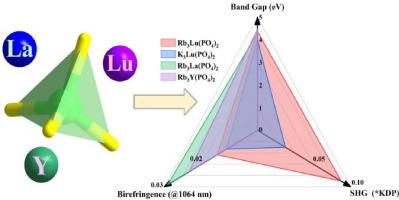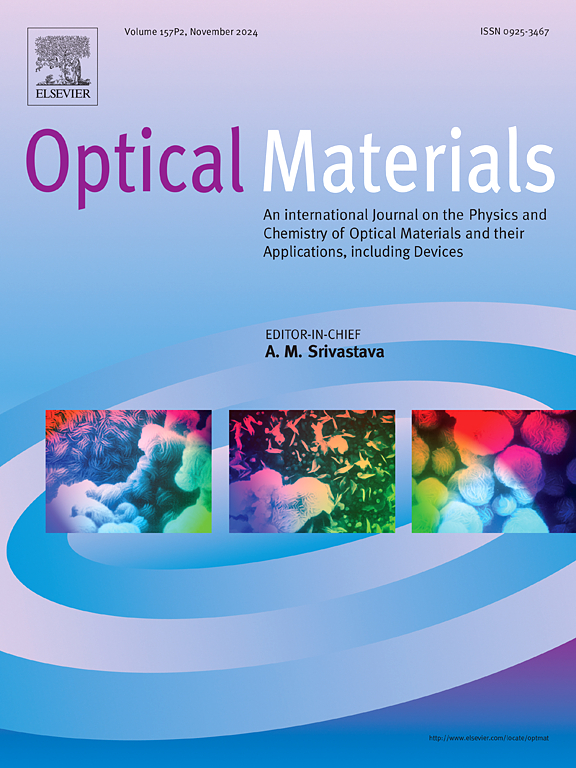Structure and optical properties of alkali rare-earth double phosphates of M3RE(PO4)2 (M = K, Rb; RE = Y, La, and Lu)
IF 3.8
3区 材料科学
Q2 MATERIALS SCIENCE, MULTIDISCIPLINARY
引用次数: 0
Abstract
Designing and synthesizing phosphate nonlinear optical materials with novel structures and excellent properties remains challenging. In this work, the electronic structure and optical properties (second harmonic generation (SHG) response or birefringence) of alkali rare-earth double phosphates M3RE(PO4)2 (M = K, Rb; RE = Y, La, and Lu) are systematically investigated. It is worth mentioning that P31m-Rb3Lu(PO4)2 was successfully synthesized by a flux-method, and the UV–vis–NIR diffuse reflectance spectroscopy showed that Rb3Lu(PO4)2 exhibits a short absorption edge at 207 nm and a high transmittance of 77.9 %. Based on first-principles calculations, the results show that the birefringence of the M3RE(PO4)2 series of crystals exhibits significant differences (0.009-0.028@1064 nm). Subsequently, analysis of the electronic structure and the real-space atom cutting method reveals that rare-earth polyhedra play a major role in enhanced birefringence. Overall, this work enriches the study of nonlinear optical crystals of rare earth phosphates and provides a case for further exploration.

M3RE(PO4)2 碱稀土双磷酸盐(M = K、Rb;RE = Y、La 和 Lu)的结构和光学特性
设计和合成结构新颖、性能优异的磷酸盐非线性光学材料仍是一项挑战。本文系统研究了碱稀土双磷酸盐 M3RE(PO4)2(M = K、Rb;RE = Y、La 和 Lu)的电子结构和光学性质(二次谐波发生(SHG)响应或双折射)。值得一提的是,采用通量法成功合成了 P31m-Rb3Lu(PO4)2,紫外-可见-近红外漫反射光谱显示,Rb3Lu(PO4)2 在 207 纳米处具有短吸收边,透射率高达 77.9%。基于第一原理计算的结果表明,M3RE(PO4)2 系列晶体的双折射存在显著差异(0.009-0.028@1064 nm)。随后,对电子结构和实空间原子切割方法的分析表明,稀土多面体在增强双折射中发挥了重要作用。总之,这项工作丰富了对稀土磷酸盐非线性光学晶体的研究,为进一步的探索提供了案例。
本文章由计算机程序翻译,如有差异,请以英文原文为准。
求助全文
约1分钟内获得全文
求助全文
来源期刊

Optical Materials
工程技术-材料科学:综合
CiteScore
6.60
自引率
12.80%
发文量
1265
审稿时长
38 days
期刊介绍:
Optical Materials has an open access mirror journal Optical Materials: X, sharing the same aims and scope, editorial team, submission system and rigorous peer review.
The purpose of Optical Materials is to provide a means of communication and technology transfer between researchers who are interested in materials for potential device applications. The journal publishes original papers and review articles on the design, synthesis, characterisation and applications of optical materials.
OPTICAL MATERIALS focuses on:
• Optical Properties of Material Systems;
• The Materials Aspects of Optical Phenomena;
• The Materials Aspects of Devices and Applications.
Authors can submit separate research elements describing their data to Data in Brief and methods to Methods X.
 求助内容:
求助内容: 应助结果提醒方式:
应助结果提醒方式:


